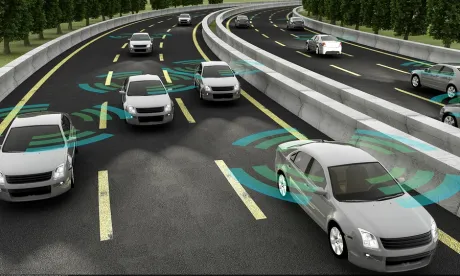The introduction of near autonomous vehicles to public roadways is set to completely revolutionize the way humans and goods navigate cityscapes in the coming years. Although Tesla’s autopilot feature has become the early pioneer, the Detroit Three, Google, Apple, Amazon, Uber, Lyft, and other manufacturers and suppliers are quickly making up ground. Meanwhile, in the areas of logistics and public transit, key stakeholders are looking for how the autonomous revolution will impact their business and propel their products and services into the next generation of transportation for goods and humans.
As if Tesla doesn’t already have a full plate with their launch of the Model 3 sedan, Elon Musk recently announced the October unveiling of their first, fully electric semi-truck, codenamed the “Beast.” While details are scarce, Reuters reports that the Beast will have a range of around 300 miles per charge, compared to a typical range of 500 miles for traditional diesel semi-trucks. Similar to their automotive cousins, it is anticipated that the Beast will come with autonomous or near autonomous functionality and also a feature called Platoon, which allows Tesla trucks to convoy together. This convoy system would “theoretically [be] safer [than traditional trucking with human drivers]—if the lead truck slows down, the rest automatically follow.” With the following trucks braking immediately, with zero reaction time, platooning can improve traffic safety. Platooning is also a cost-saver as the trucks drive close together at a constant speed. This means lower fuel consumption and less CO2 emissions. Platooning also efficiently boosts traffic flows thereby reducing tail-backs. Meanwhile the short distance between vehicles means less space taken up on the road. This system would allow trucking companies to reduce unnecessary braking and acceleration on their routes, reducing fuel use, breaking wear and tear, and engine wear. The developers also note that using Platoon to transport en masse “also offers most of the trucks decreased wind resistance, which could help increase an EV semi’s range…”.
But Tesla isn’t the only player in town. DAF Trucks, Daimler, IVECO, MAN, Scania, and Volvo have been working with the Dutch Ministry of Infrastructure and the Environment on similar technology. In mid-2016, the Ministry of Infrastructure and the Environment put on, and the six manufactures successfully completed, the European Truck Platooning Challenge. This Challenge resulted in trucks successfully platooning from six cities in Denmark, Sweden, Belgium, and Germany to the Port of Rotterdam en masse on April 6, 2016. This competition and the resulting data has driven the European market ahead with development of autonomous trucking corridors and regulations meant to accelerate the adoption of level-3 and -4 autonomous trucking systems throughout the EU, seeing the cost and efficiency benefits brought by autonomous systems. While nothing has been fully implemented as of yet, it appears EU regulations will begin to roll out in the coming years as member states continue to evaluate the opportunities and risks associated with this technology.
Meanwhile in the United States, Freightliner/Daimler have had an NHTSA level-3 truck on the road since 2015 with a goal of market-ready vehicles for sale by 2020; Uber’s Otto division began testing its semi-autonomous truck in 2016 with a goal of 24/7 trucking by allowing the driver to sleep in the back of the cab during long-transit hauls; and Starsky Robotics has developed an aftermarket autonomous system which would allow existing trucks to be retrofitted with autonomous capabilities and allow the driver to operate the vehicle remotely. Additionally, Amazon has begun to evaluate the ability to use autonomous technology to further streamline its logistics systems and reduce delivery times for products sold through its online platforms. While many manufactures are beginning to entertain autonomous technology in their next-generation trucks, the transition to Level 2 or 3 autonomous technology will face a long haul as legislatures mull the implications for safety and job loss in one of the most common occupations in the United States.
The notion roadways being full of autonomous trucks platooning down the road and trucks being piloted by remotely connected drivers is still in its infancy. But the idea of being shuttled around a city or college campus by a driverless bus, train, or shuttle is already a reality. As cities and companies evaluate the ever-changing needs of consumers and the public from a public-transit standpoint, a new era of public-private partnership is driving the introduction of autonomous systems into the transit conversation.
The University of Michigan recently announced the launch of its driverless North Campus shuttle for university students and staff. The project is a collaboration between the University’s MCity Project and NAVYA, the French manufacturer of the system. While currently limited to a small two mile loop on the University’s north campus, the eventual goal is to increase the systems capacity to shuttle students around town and between the University’s four Ann Arbor campus locations.
Similarly, Ann Arbor-based May Mobility, in collaboration with Detroit-based Quicken Loans, will soon begin short-term testing of their autonomous shuttle in Detroit during mid-October. If successful, many anticipate a system of May Mobility vehicles being deployed by cities or companies around the country to shuttle employees and members of the public along designated routes. Meanwhile, European based Transdev Technologies has begun rolling out and testing autonomous shuttle systems in the United States. Currently, Transdev is “driving” their autonomous shuttle across the United States with a most recent stop in Atlanta, GA, a burgeoning autonomous testing ground. Transdev currently transports over 4,000 passengers per day in two self-driving deployments in Europe, with deployments in the United States in active design and development around the country.



 />i
/>i

